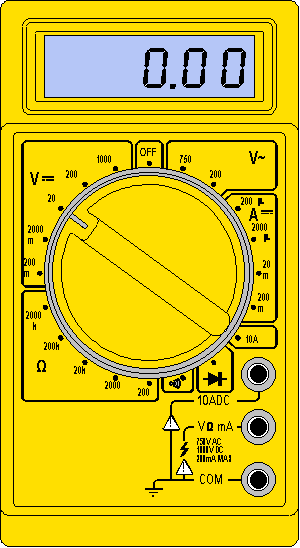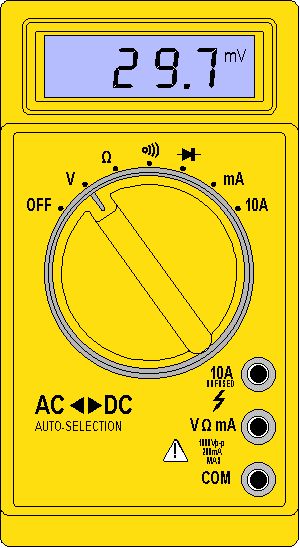 sing a Digital Multimeter
sing a Digital Multimeter
Even
the simplest and cheapest types of multimeter may include features which you are not likely to
use, as they have been designed and mass produced for electronics engineers.
Digital meters give a numeric output, usually on a liquid crystal
display.
There are two types that you may come across in practical sessions:
 The switched range multimeter:
The switched range multimeter:


The central knob has lots of positions and you must choose which one is
appropriate for the measurement you want to make.
You have to connect a black probe lead into the socket marked COM (which is short for COMMON - as it is the connection that has to be made for whatever use the meter is being employed for).
A red probe lead is connected into the socket labelled
V=ΩmA.
(The 10 ADC socket
is very rarely used).
Measuring DC voltages

- no, not Detective Comics  - DC stands for direct current.
- DC stands for direct current.
In any circuit
which operates from a steady voltage source, such as a battery, current flow is
always in the same direction. At GCSE most circuits you will work with will be DC circuits.
There are several DC ranges within the DC section of the meter - indicated by  (a flat, steady voltage line).
(a flat, steady voltage line).
If the meter is switched
to 20 V DC, then
20 V is the maximum voltage which can be measured, This is sometimes called
20 V fsd, where fsd is short for full scale
deflection.
For circuits with power supplies of up to 20 V, which includes all the
circuits you are likely to build at GCSE level, the 20 V DC voltage range
is the most useful.
Sometimes, you will want to measure smaller voltages, and in this case, the
2 V or 200 mV ranges are used so you can get a more sensitive reading.
Measuring AC voltages

AC stands for alternating current.
In any appliance connected
to the domestic mains electricity, current flows first one way, then the opposite through its circuitry - the current reverses, or alternates, in direction.
In the States the
current reverses 50 times per second - it has a frequency of 60 Hz; whereas UK mains has a frequency of 50 Hz, the
current reverses 50 times per second.
 |
For safety reasons, you must NEVER connect a multimeter
to the mains supply. |
AC is indicated by  , on your
multimeter but you are not likely to use the AC ranges at GCSE Level.
, on your
multimeter but you are not likely to use the AC ranges at GCSE Level.
 The autoranging
multimeter:
The autoranging
multimeter:

This is a simpler form - the central knob has fewer positions, and all you need to do is to switch it
to the quantity you want to measure.
Once switched to V, the meter automatically adjusts its range to give a meaningful
reading, and the display includes the unit of measurement, V or mV.
You have to connect a black probe lead into the socket marked COM (which is short for COMMON - as it is the connection that has to be made for whatever use the meter is being employed for).
A red probe lead is connected into the socket labelled
V=ΩmA.
(The 10 ADC socket
is very rarely used).
This type of meter is more expensive, but obviously much
easier to use.
 Much of the information and some of the images in this topic were taken from doctronics.co.uk - a brilliant, now defunct site that I used to direct my students towards. I have been unable to find out what happened to this site - but gladly I had saved some of the information for use in my lessons... and I now share them with you!
Much of the information and some of the images in this topic were taken from doctronics.co.uk - a brilliant, now defunct site that I used to direct my students towards. I have been unable to find out what happened to this site - but gladly I had saved some of the information for use in my lessons... and I now share them with you!
![]() , on your
multimeter but you are not likely to use the AC ranges at GCSE Level.
, on your
multimeter but you are not likely to use the AC ranges at GCSE Level. The autoranging
multimeter:
The autoranging
multimeter:
 Much of the information and some of the images in this topic were taken from doctronics.co.uk - a brilliant, now defunct site that I used to direct my students towards. I have been unable to find out what happened to this site - but gladly I had saved some of the information for use in my lessons... and I now share them with you!
Much of the information and some of the images in this topic were taken from doctronics.co.uk - a brilliant, now defunct site that I used to direct my students towards. I have been unable to find out what happened to this site - but gladly I had saved some of the information for use in my lessons... and I now share them with you!

 sing a Digital Multimeter
sing a Digital Multimeter






